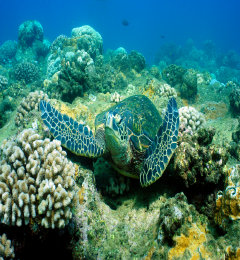Sea Turtles Threatened
Sea Turtles Endangered
As the hand of man has extended into and along the oceans with industry, development, and tourism, the sea turtle has suffered greatly. Pollution, invasion of habitat, accidental capture in fishing nets, collision with boats, and human consumption are but a few of the forces threatening the existence of these trusting creatures. Currently, 6 species of marine turtles are listed as threatened or endangered and receive protection under the federal Endangered Species Act. This prohibits anyone from injuring, taking, holding captive, harassing, or killing a species. This protection also extends considerable power to enforce the recovery of a species or to protect its habitat. Along with the Leatherback, Hawksbill, Kemp Ridley, and Olive Ridley sea turtles, the Green Sea Turtle is considered endangered. The Loggerhead Sea Turtle is listed as Threatened. Fines for violating laws that protect sea turtles can reach $100,000 and include imprisonment.
HawaiiSeaTurtle.com
A N Y W H E R E !
A N Y T I M E !
An Endangered Species
Endangered status signifies that a species is considered in danger of extinction throughout all or a significant part of its range. In effect, it will be gone from this planet forever. Threatened means that the species is likely to become endangered. The Green Sea Turtle is also listed as Endangered by ICUN (The World Conservation Union) and CITES (Convention on International Trade in Endangered Species). As such, it is illegal to import or export turtle products for endangered species. The Green Sea Turtle also receives protection under Hawaii State law.
Endangered versus Threatened?

Green Sea Turtles face a threat of epidemic proportions from a viral predator called Fibropapillomatosis. This herpes-like virus causes multiple debilitating tumors that manifest both internally and externally. At one point, it was believed that this condition would cause the extinction of all sea turtles. However, recent evidence suggests that a sea turtle may actually recover from this disease. Internal tumors can occur in the lungs or other vital organs, sometimes leading to death. Young sea turtles appear to have a higher mortality rate than adult turtles inflicted with this disease. It is believed that the occurrence of this virus is related to impacts of run-off from agricultural, industrial, or urban development. It is theorized that the immune system of turtles in habitats in close proximity to dense urban environments may be weakened, thus resulting in higher susceptibility to Fibropapillomatosis.
Fibropapillomatosis
The Hubris of Man
Despite being illegal in many countries, sea turtles are still hunted for their flesh. Turtle eggs are considered a delicacy or aphrodisiac in some cultures and stolen from nests. It's estimated that thousands of marine animals, including sea turtles, die each year from entanglement or ingestion of plastic. This includes plastic bags and soda can holders. Sea turtles can mistake plastic bags for food, such as jellyfish. Once ingested, they can cause suffocation or gastric blockage resulting in death. Thus, it's important for people to reduce, reuse, and recycle plastic. Many turtles die from being caught in long line or gill nets, as well as discarded fishing line. Because they have lungs and must surface to breath, trapped and entangled sea turtles quickly drown.

HawaiiSeaTurtle.com



Sea Turtle Shop



